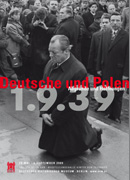


Exhibition | Oppression and Self-assertion | War and Occupation | Conflicts and Rapprochements
The Federal Republic of Germany and Poland Through 1989
| "Friendship" under the Socialist Order
Memories of the War and Polish Perception of Germany
| "A Difficult Episode"
Since 1945, Polish memory of the war has focused on the victims of the German occupation and the Polish resistance movement. Prior to 1989, remembrances of the war were dominated by the role of the communists in Poland's resistance struggle, while other resistance movements were barely mentioned. Once communist rule was overthrown, however, Poles began to confront sensitive historical questions which had been taboo up to that point.
Like Polish memory of the war, Poland's perception of Germany has changed considerably since the end of the war. At first, while memory of German war crimes was still fresh, Poles were hostile towards Germany. Following the partition of Germany, East Germany was considered to be a friendly state while West Germany was viewed for a long time as a revanchist enemy. Following the 1970 Treaty of Warsaw, however, the official concept of the "good" and "bad" Germany became less convincing.
